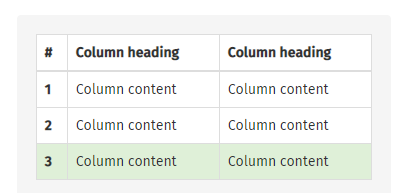前言
每个测试用例需要加断言,Cypress里面断言常用的有should, expect
隐式断言
.should()
可以使用.should()给当前用例加断言
- should('have.class', 'success') 断言元素的class属性值是 'success'
- should('have.text', 'Column content') 断言元素文本值 'Column content'
- should('contain', 'Column content') 断言元素文本包含 'Column content'
- should('have.html', 'Column content') 断言元素html文本'Column content'
- should('match', 'td') chai-jquery 使用 "is()"检查元素是否与选择器匹配
- .invoke('text')
.should('match', /column content/i) 文本与正则表达式匹配先使用invoke结合should - .contains('text') 文本与正则表达式匹配元素文本包含,这种比上面更好
<table class="table table-bordered assertion-table">
<thead>
<tr>
<th>#</th>
<th>Column heading</th>
<th>Column heading</th>
</tr>
</thead>
<tbody>
<tr>
<th scope="row">1</th>
<td>Column content</td>
<td>Column content</td>
</tr>
<tr>
<th scope="row">2</th>
<td>Column content</td>
<td>Column content</td>
</tr>
<tr class="success">
<th scope="row">3</th>
<td>Column content</td>
<td>Column content</td>
</tr>
</tbody>
</table>

cy.get('.assertion-table')
.find('tbody tr:last').should('have.class', 'success')
.find('td')
.first()
// checking the text of the element in various ways
.should('have.text', 'Column content')
.should('contain', 'Column content')
.should('have.html', 'Column content')
// chai-jquery uses "is()" to check if element matches selector
.should('match', 'td')
// to match text content against a regular expression
// first need to invoke jQuery method text()
// and then match using regular expression
.invoke('text')
.should('match', /column content/i)
// a better way to check element's text content against a regular expression
// is to use "cy.contains"
// https://on.cypress.io/contains
cy.get('.assertion-table')
.find('tbody tr:last')
// finds first element with text content matching regular expression
.contains('td', /column content/i)
.should('be.visible')
.and()
针对同一元素多个断言,可以使用 and 语法
cy.get('.assertions-link')
.should('have.class', 'active')
.and('have.attr', 'href')
.and('include', 'cypress.io')
显示断言
expect()
针对项目 BDD 断言方式
expect(true).to.be.true
const o = { foo: 'bar' }
expect(o).to.equal(o)
expect(o).to.deep.equal({ foo: 'bar' })
// matching text using regular expression
expect('FooBar').to.match(/bar$/i)
assert()
针对项目 BDD 断言方式
const person = {
name: 'Joe',
age: 20,
}
assert.isObject(person, 'value is object')
Should with callback function
下面这段我也看不懂了,不翻译了
You can write your own complicated checks using .should(cb) function if included assertions are not enough. Pass a function to should() with any number of explicit assertions within it. The callback function will be retried until it passes all your explicit assertions or times out.
cy.get('.assertions-p').find('p')
.should(($p) => {
// return an array of texts from all of the p's
let texts = $p.map((i, el) => // https://on.cypress.io/$
Cypress.$(el).text())
// jquery map returns jquery object
// and .get() convert this to simple array
texts = texts.get()
// array should have length of 3
expect(texts).to.have.length(3)
// use second argument to expect(...) to provide clear
// message with each assertion
expect(texts, 'has expected text in each paragraph').to.deep.eq([
'Some text from first p',
'More text from second p',
'And even more text from third p',
])
})
Assert that element's class includes heading-.
cy.get('.docs-header').find('div')
// .should(cb) callback function will be retried
.should(($div) => {
expect($div).to.have.length(1)
const className = $div[0].className
expect(className).to.match(/heading-/)
})
// .then(cb) callback is not retried,
// it either passes or fails
.then(($div) => {
expect($div).to.have.text('Introduction')
})
You can throw any error from the callback function. The callback will be retried, but the assertions will not be shown as nicely in the Command Log UI as Chai assertions.
cy.get('.docs-header').find('div')
.should(($div) => {
if ($div.length !== 1) {
// you can throw your own errors
throw new Error('Did not find 1 element')
}
const className = $div[0].className
if (!className.match(/heading-/)) {
throw new Error(`Could not find class "heading-" in ${className}`)
}
})
We strongly recommend that your tests are deterministic. But sometimes you might need to match text between two elements, and you do not know what that text should be. Save the value from the first element, then compare it from a should(cb) callback.
let text
/**
* Normalizes passed text,
* useful before comparing text with spaces and different capitalization.
* @param {string} s Text to normalize
*/
const normalizeText = (s) => s.replace(/s/g, '').toLowerCase()
cy.get('.two-elements')
.find('.first')
.then(($first) => {
// save text from the first element
text = normalizeText($first.text())
})
cy.get('.two-elements')
.find('.second')
.should(($div) => {
// we can massage text before comparing
const secondText = normalizeText($div.text())
expect(secondText, 'second text').to.equal(text)
})